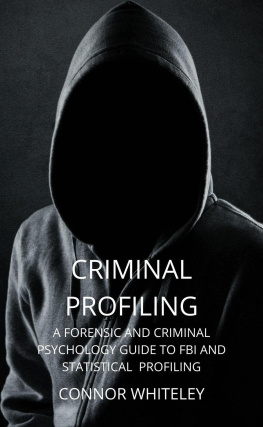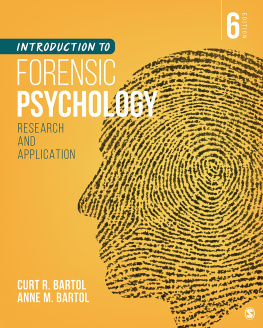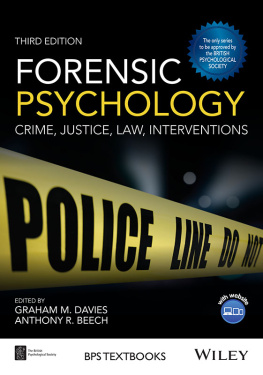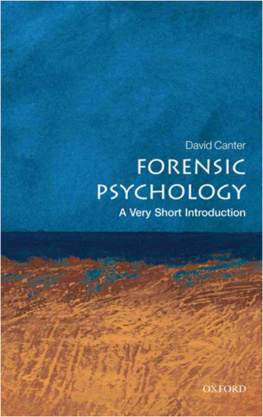Fanetti Matthew - Forensic child psychology: working in the courts and clinic
Here you can read online Fanetti Matthew - Forensic child psychology: working in the courts and clinic full text of the book (entire story) in english for free. Download pdf and epub, get meaning, cover and reviews about this ebook. City: Hoboken;New Jersey, year: 2015;2014, publisher: Wiley, genre: Romance novel. Description of the work, (preface) as well as reviews are available. Best literature library LitArk.com created for fans of good reading and offers a wide selection of genres:
Romance novel
Science fiction
Adventure
Detective
Science
History
Home and family
Prose
Art
Politics
Computer
Non-fiction
Religion
Business
Children
Humor
Choose a favorite category and find really read worthwhile books. Enjoy immersion in the world of imagination, feel the emotions of the characters or learn something new for yourself, make an fascinating discovery.
- Book:Forensic child psychology: working in the courts and clinic
- Author:
- Publisher:Wiley
- Genre:
- Year:2015;2014
- City:Hoboken;New Jersey
- Rating:4 / 5
- Favourites:Add to favourites
- Your mark:
- 80
- 1
- 2
- 3
- 4
- 5
Forensic child psychology: working in the courts and clinic: summary, description and annotation
We offer to read an annotation, description, summary or preface (depends on what the author of the book "Forensic child psychology: working in the courts and clinic" wrote himself). If you haven't found the necessary information about the book — write in the comments, we will try to find it.
Forensic child psychology: working in the courts and clinic — read online for free the complete book (whole text) full work
Below is the text of the book, divided by pages. System saving the place of the last page read, allows you to conveniently read the book "Forensic child psychology: working in the courts and clinic" online for free, without having to search again every time where you left off. Put a bookmark, and you can go to the page where you finished reading at any time.
Font size:
Interval:
Bookmark:

Cover image: iStockphoto/jammydesign
Cover design: Wiley
This book is printed on acid-free paper  .
.
Copyright 2015 by John Wiley & Sons, Inc. All rights reserved.
Published by John Wiley & Sons, Inc., Hoboken, New Jersey.
Published simultaneously in Canada.
No part of this publication may be reproduced, stored in a retrieval system, or transmitted in any form or by any means, electronic, mechanical, photocopying, recording, scanning, or otherwise, except as permitted under Section 107 or 108 of the 1976 United States Copyright Act, without either the prior written permission of the Publisher, or authorization through payment of the appropriate per-copy fee to the Copyright Clearance Center, Inc., 222 Rosewood Drive, Danvers, MA 01923, (978) 750-8400, fax (978) 646-8600, or on the web at www.copyright.com. Requests to the Publisher for permission should be addressed to the Permissions Department, John Wiley & Sons, Inc., 111 River Street, Hoboken, NJ 07030, (201) 748-6011, fax (201) 748-6008.
Limit of Liability/Disclaimer of Warranty: While the publisher and authors have used their best efforts in preparing this book, they make no representations or warranties with respect to the accuracy or completeness of the contents of this book and specifically disclaim any implied warranties of merchantability or fitness for a particular purpose. No warranty may be created or extended by sales representatives or written sales materials. The advice and strategies contained herein may not be suitable for your situation. You should consult with a professional where appropriate. Neither the publisher nor authors shall be liable for any loss of profit or any other commercial damages, including but not limited to special, incidental, consequential, or other damages.
This publication is designed to provide accurate and authoritative information in regard to the subject matter covered. It is sold with the understanding that the publisher is not engaged in rendering professional services. If legal, accounting, medical, psychological or any other expert assistance is required, the services of a competent professional person should be sought. The views and opinions presented in this book are solely those of the authors and do not necessarily represent those of the Federal Bureau of Investigation.
Designations used by companies to distinguish their products are often claimed as trademarks. In all instances where John Wiley & Sons, Inc. is aware of a claim, the product names appear in initial capital or all capital letters. Readers, however, should contact the appropriate companies for more complete information regarding trademarks and registration.
For general information on our other products and services please contact our Customer Care Department within the United States at (800) 762-2974, outside the United States at (317) 572-3993 or fax (317) 572-4002.
Wiley publishes in a variety of print and electronic formats and by print-on-demand. Some material included with standard print versions of this book may not be included in e-books or in print-on-demand. If this book refers to media such as a CD or DVD that is not included in the version you purchased, you may download this material at http://booksupport.wiley.com. For more information about Wiley products, visit www.wiley.com.
ISBN 978-1-118-27320-3 (print)
ISBN 978-1-118-42115-4 (e-Pub)
ISBN 978-1-118-41958-8 (ePDF)
ISBN 978-1-118-65231-2 (e-Mobi)
The field of forensic psychology has grown slowly over the past century. From the early debates by Hugo Munsterberg and Sigmund Freud that psychology should play a larger role in the legal system, to the use of psychology in advocating the elimination of segregation in schools in the U.S. Supreme Court case Brown v. Board of Education, psychology has struggled to help legal decision makers be better informed. The past five decades have seen an exponential growth in the use of scientific research to answer important questions in forensics, from matters such as bystander inaction to the strengths and frailties of the memories of eyewitnesses. In the 1990s, psychology responded to a rash of well-publicized day-care child sexual abuse scandals, with a push for scientific understanding of children's allegations of sexual abuse. In just 25 years, the applied field of child sexual abuse assessment has come from an ad hoc and unstandardized approach to assessment, characterized by wild disagreements and untrained assessors, to a (mostly) highly controlled approach, which is informed by research with an aim to understand and reduce error. In our estimation, this is a very desirable outcome of mere decades. Psychology can work with the applied community and it can help to work toward better responses to real problems. Ultimately, this was the position of Munsterberg and Freud, though the field at the time was not ready to provide the necessary support.
College instructors today have an interesting problem: finding a text that supports the goals of their classes in forensic psychology. Unlike courses such as the typical general Introduction to Psychology experience (for which available texts are plentiful and varied), undergraduate texts in forensic psychology are rare. Even worse, those with a focus on child issues are even more rare. Compound this with the fact that most available texts are written for students with strong backgrounds in psychology (or graduate students and professors in psychology) and what does an instructor do for a forensic psychology course filled with sophomores in social work, criminology, nursing, premed, and so on? These students need to understand some basic principles, because these principles affect an everyday working environment. However, many students do not have sufficient background in psychology to use an advanced forensic psychology text. Furthermore, they have little need of many of the specific topics discussed in those texts.
The overarching goal of this text is to provide an accessible and basic examination of psychology and law pertaining to children so that students who will enter into the workforce with need of this kind of information will be better prepared. We have focused on writing style and ease of use. Rather than a text that explores every permutation of every relevant concept, we focus on a clear and well-explained iteration of basic ideas. The goal is clarity and understanding, not comprehensive depth.
The first focus of the text is a basic review of some concepts in psychology that may be important to those who actually work in forensic environments, including (1) why psychology is a science and why that is important, (2) relevant social and learning psychology, (3) relevant psychopathology, and (4) basic concepts in memory as applied to forensics.
The second focus of the text is an examination of specific topics and concepts related to child forensics, including (1) an overview of child abuse and exploitation, (2) child abuse in the modern technological world, (3) pedophilia and child molestation, (4) assessment of child sexual abuse, and (5) treatment of children who have been abused.
The third and final focus of this text is to provide a basic understanding of the legal world related to child forensics, including (1) basic concepts in law, (2) mandated reporting, (3) juvenile justice systems, and (4) the role of psychological expert witnesses in child abuse cases.
Ultimately, we hope that the text provides a sound framework for building new courses that are specifically designed for those who will be working directly with children. We are hoping to have built an accessible entry point into the field for some and an understandable set of working principles for others.
Next pageFont size:
Interval:
Bookmark:
Similar books «Forensic child psychology: working in the courts and clinic»
Look at similar books to Forensic child psychology: working in the courts and clinic. We have selected literature similar in name and meaning in the hope of providing readers with more options to find new, interesting, not yet read works.
Discussion, reviews of the book Forensic child psychology: working in the courts and clinic and just readers' own opinions. Leave your comments, write what you think about the work, its meaning or the main characters. Specify what exactly you liked and what you didn't like, and why you think so.










